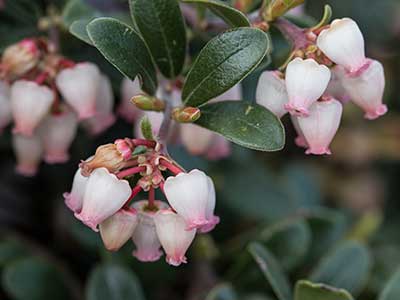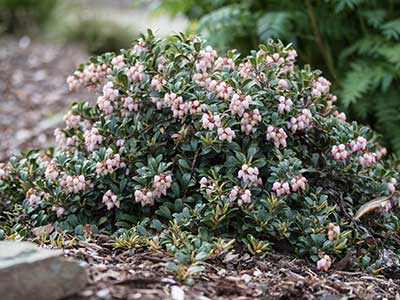Kinnikinnick
- Scientific Name: Arctostaphylos uva-ursi
- Garden: Natives Garden, Rain Garden, Wildlife Garden
- Plant Type: Ground Cover
- Evergreen/Deciduous: Evergreen
- Sun/Shade Exposure: Full Sun or Part Shade
- Moisture Requirements: Dry
Plant Information
As a low growing, drought tolerant evergreen groundcover, kinnikinnick or bear-berry as it is commonly referred to, is planted for its crisp foliage, white flowers, and red fall fruit. Morphology: Evergreen ground cover, 6-12+ inches tall, branches root where they touch the soil, mat-forming. Leaves have an alternate arrangement, are simple, form an oblong shape, and grow up to 1” long. Leaves are lustrous dark green above, lighter below. Flowers are considered to be perfect (contain both male and female parts), white-tinged pink, and formed as nodding urn-shaped structures, as with other plants in the manzanita family. Fleshy fruit bright red (known as drupes) may form in late summer. When fruit do form the local songbirds and squirrels will consume them all quickly. Adaptation: Sun or partial shade. Difficult to transplant. Does best in poor, sandy, infertile, acid soils. Once established, kinnikinnick withstands drought and full sun exposure and does best in coarse, low-nutrient soils. It is not competitive on richer sites. It is slow to start growing, so plant densely or intermix with a fast grower if quick coverage is important. After a year or two, kinnikinnick will spread more rapidly to form mats. In the home landscape bear-berry is an ideal choice for hillside or sloping area, or as rockery planting. In a lawn it can be used as a ground cover in tree and shrub beds. In commercial settings this groundcover is used extensively along parking strip medians. Pests: None reported.
Data Source
https://www.pnwplants.wsu.eduPlant Photos







